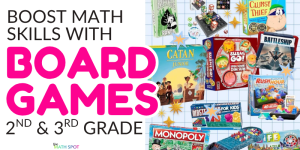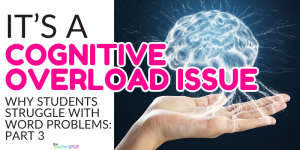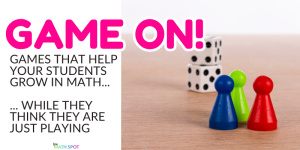If you’ve been following along with our Word Problem Bootcamp, we’ve already looked at two big challenges. In Week 1, we talked about comprehension, when students don’t truly understand what’s happening in the story. In Week 2, we talked about connection, when students understand the story but can’t yet connect it to the right operation.
This week we’re tackling the third challenge: cognitive load.
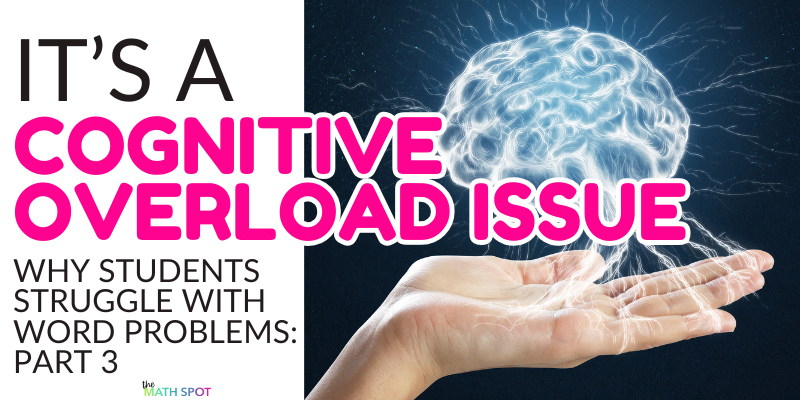
When Word Problems Feel Overwhelming
For some students, the issue isn’t understanding the story or knowing the operations. The problem is the mental effort required to pull everything together. These are the students who start circling numbers and underlining questions because it feels like the only way to make sense of the problem. They might also be the students who pluck out every number they see and add them together just to have an answer on the page. These students aren’t intentionally trying to be careless. These are coping mechanisms for students who are overwhelmed by the entire process.
Think about what we are asking of them: read the story, interpret what’s happening, understand what the question is asking, determine which operation or operations make sense, and finally carry out the computation. That’s a heavy lift. When all of those steps are stacked together, students who are still developing their reasoning skills often hit cognitive overload.
In order to help students who are experiencing this cognitive overload challenge we can manage the load by breaking the problem-solving process into smaller, more manageable parts by implementing chunking activities. These activities focus on just one piece of the task before putting it all together.
Strategy #1: Numberless Word Problems
Numberless word problems give students space to think. Instead of handing them a full story with numbers and a question right away, you present only a small piece of the situation and build from there. This allows students to focus on what’s happening in the story before they ever see a number.
Each slide or sentence introduces one new piece of information. After each reveal, you pause and talk about what’s changed. Students think, reason, and visualize the story before they ever calculate.
Example:
Slide 1: Some birds are sitting on a power line. Some more birds fly over. Now the whole group of birds are sitting on the power line.
Ask: What is happening in this story? Who are the main characters? Where are they? Is the group of birds getting bigger or smaller?
Slide 2: Some birds are sitting on a power line. Some more birds fly over. Now 13 birds are sitting on the power line.
Ask: What new information do we have? Could the power line have started with 100 birds? Why or why not?
Slide 3: Five birds are sitting on a power line. Some more birds fly over. Now 13 birds are sitting on the power line.
Ask: What new information do we have? Can we draw a model that matches this story?
Slide 4: Five birds are sitting on a power line. Some more birds fly over. Now 13 birds are sitting on the power line. How many birds flew over?
Ask: What is the story wondering? How might our model help us solve it?
When you walk through the story in small steps, you are lowering the cognitive demand while building the reasoning process. Students are no longer trying to juggle reading, interpreting, and calculating all at once. Better yet, when you use numberless word problems, you are modeling the thought process so that in the future, your students will be able to move through problems with more focus and confidence.
Strategy #2: Word Problem Sorts
Another way to reduce the load is to take solving completely off the table, at least for a while. Instead of asking students to solve ten problems, ask them to sort them.
For example, a first-grade teacher working on “put together” and “take apart” problems might give students a set of problems where some are missing a part and others are missing the total. Students read each story and sort them into two groups, missing part or missing total.
That might be the whole activity.
If you want to extend it, students can draw a part-whole diagram to match each story, label the known parts, and place a question mark for what’s missing.
And that might be the whole activity.
Or you can go a step further and have them solve, but be sure to loop back afterward and ask: How does our equation match our story? Does our answer make sense?
The trick here is that you are focusing on one piece of the process at a time. Sorting, modeling, and reasoning all happen without overloading students with steps. I have a set of sort and solve word problems ready to go for 1st grade teachers if you would like to try this strategy right away!
Strategy #3: Model Match Games
For this activity, prepare a set of story problem cards and a matching set of model cards. Try to use the same or similar numbers in all the stories so the focus stays on structure rather than computation.
Ask students to read each problem and match it to the model that shows what is happening in the story. You can stop there, or extend the activity by having students pick one matched pair and write an equation to go with it to solve.
Model match games reduce the cognitive load because students aren’t asked to read, visualize, and write all at once. They get to see the structure and connect it to meaning.
They also give you great insight into where your students might need support! Can they match stories to models? Can they write equations to match models? Can they accurately calculate to solve? Each of those tells you something different about what to target next.
Bringing It All Together
When we break down word problems into smaller pieces, we make space for reasoning to grow. Chunking the task doesn’t mean simplifying the thinking. It means giving students room to think about one part of the process at a time.
Whether you’re using numberless word problems, problem sorts, or model match games, the goal is the same: help students feel confident, not overwhelmed!
Related Resources

